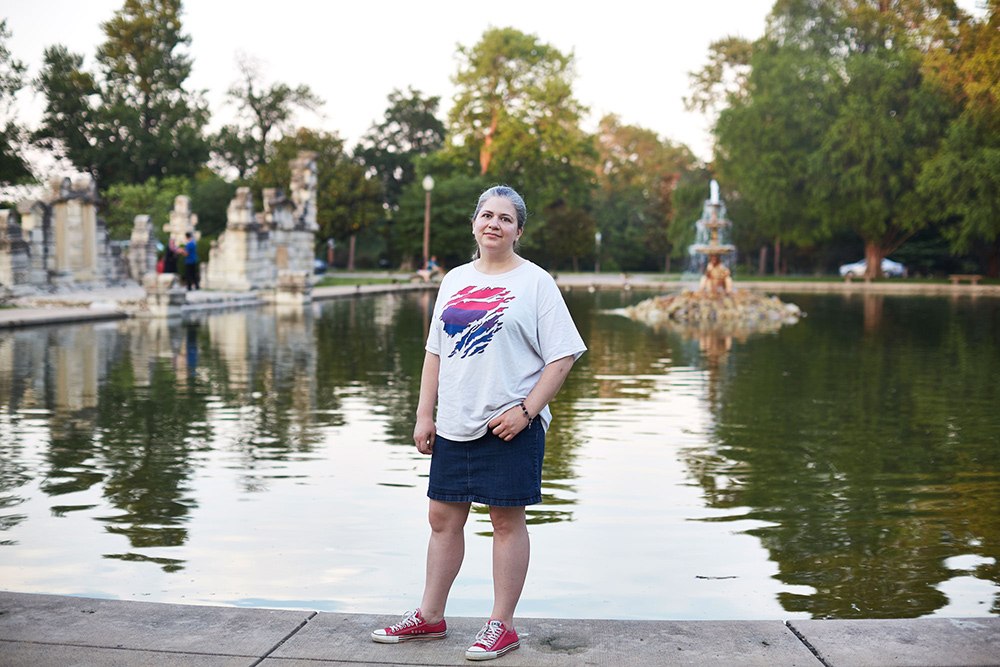If you went to Tower Grove Pride last year, maybe you saw a quietly revolutionary booth. It hoisted pink, lavender and blue flags for bisexual pride.
Amid the immediately recognizable rainbow flags that have drenched Pride celebrations for decades, the bisexual flag is still uncommon — despite some estimates, including a 2011 study by the Williams Institute, counting fully half of the LGBT population as bisexual.
To one St. Louis woman, that presented a problem and an opportunity.
Justine Collum’s booth had nothing for sale. She was handing out information, pins and a zine, all celebrating the bisexual experience. She was filling a void, as well as affirming her own identity — something she intends to do again at Tower Grove Pride this year.
“I didn’t realize I was bi until I was like fifteen years old,” Collum, now 35, says. She wasn’t fully out for almost two decades after that. “It’s a visibility issue. In my head it was like, ‘You can be straight or gay,’ and I knew I liked boys, so how could I be gay?”
Even after figuring things out, Collum kept her orientation mostly to herself for a long time. People thought she was just into guys. But after the grisly mass shooting at Pulse nightclub in Orlando in 2016, Collum was inspired to share her identity publicly as a bisexual woman.
In the wake of such horror on the very eve of St. Louis’ Pride celebrations, she explains, she needed to be with her queer community in a public and decisive way, not just as the apparent straight ally she’d always been.
“That was my first year going to Pride as part of the community,” she explains today.
Bisexuality is often poorly understood, written off as a phase or seen as a hedge against coming out as fully gay. Perhaps as a result, bi folks are far less likely to be out than gays or lesbians, according to a 2013 Pew Research Center report.
In a 2014 presentation at the National LGBT Health Education Center, bisexual activist and educator Robyn Ochs identified plenty of eye-rollingly familiar stereotypes about bisexuality: “in denial,” “bi now, gay later,” “greedy” and “just experimenting.” Bisexual people, she said, are sometimes told by gay men and lesbians that they have it easy, and that their pain is less real.
As for Collum, she realized she’d never seen a bi-specific booth in her years of attending the region’s various Pride celebrations. Her next step was clear: In 2017, she created a booth of her own for Tower Grove Pride, celebrating and informing attendees about bi- and pansexual people. She did a little bit of fundraising to cover booth fees as well as buttons, magnets and a zine for handout.
“I just went and threw up some flags,” she says. “There were people who saw the bi and pan flags flying and, like, ran across the street. They were like, ‘Those are our flags!’”
Claiming a queer identity that’s neither gay nor straight is a challenge in a world that prefers the binary: gay or straight, male or female. Rejection and erasure can come from straight and queer people alike.
Chet Cain, 48, is one of the main facilitators for BASL, the Bisexual Alliance of St. Louis. He didn’t realize he was bi until his twenties, he says. For him, bisexuality brings a certain amount of coming-out fatigue. How many times do you have to bring it up, especially if you settle down in a relationship that presents a certain way?
“If you get married to an opposite-sex person and you have kids and you end up in the suburbs, you don’t talk about it much and you’re just another person in the subdivision,” Cain says. “Depending on who we’re with or what context we’re in, we can easily be assumed to be either straight or gay, just because people find it simpler to say one or the other. That’s part of the reason bi invisibility happens — you don’t know the whole history of someone’s sexuality.”
Samati Niyomchai, 30, came out as bi in high school, after some uncertainty related to knowing that he was attracted to both men and women but not quite knowing what that meant. He says that he expects a certain amount of ignorance related to his bisexuality. As he’s gotten older, it bothers him less.
“When people are like, ‘That’s not real,’ OK, that’s stupid. I know who I am and what I want.”
He says that perhaps the mix of his Asian heritage and lack of hypermasculinity are what cause people to read him as not straight, but he still finds it important to be out as a bisexual person all the time, both to claim space on a personal level and to challenge society’s assumptions.
“That means fielding some ignorant questions, but it also means being able to be radically authentic,” he says.
Yet Niyomchai still gets extra frustrated with institutions, even well-meaning ones. He points to the Human Rights Campaign’s “gay marriage” crusade, which erased the desire for matrimony from anyone besides two lesbians or two gay men.
“I’m tired and frustrated,” he says. “We know better — in theory.”
And we’ve known it for years. In fact, a bisexual woman named Brenda Howard was instrumental in deciding that every June, the riots at Stonewall should be commemorated. Keep that in mind when you pass by Justine Collum’s booth at Tower Grove Pride this year. She’ll be there with a dose of truth — and a reminder that it’s not just L, G and T we’re celebrating. “B” is right there in the midst of the party.



